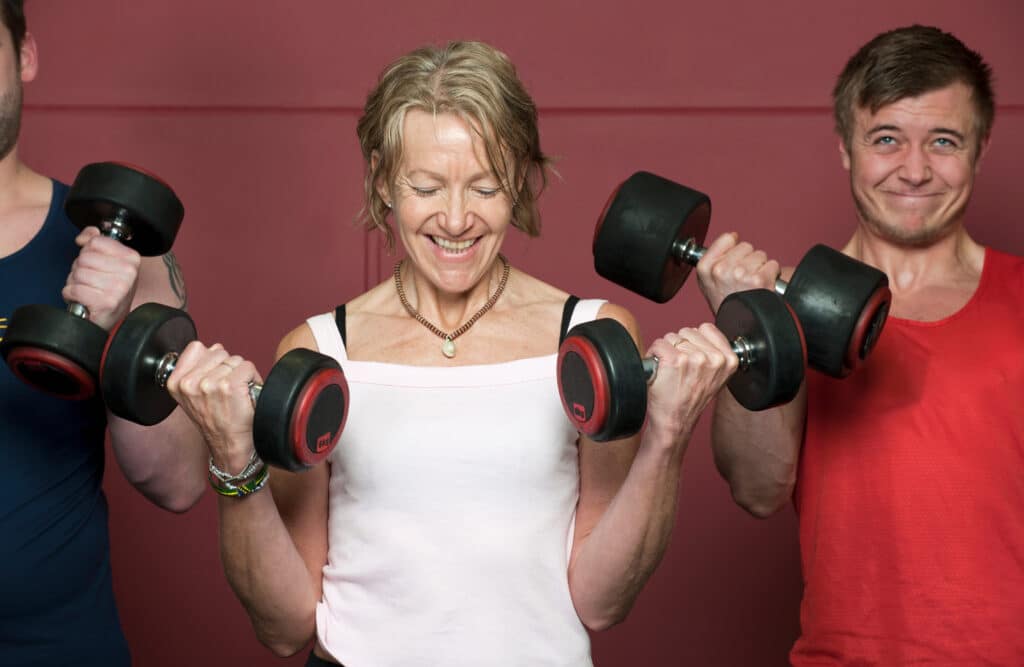The SAID principle is considered a cornerstone of modern physical therapy. But what exactly is the SAID principle?
Originally devised for athletic training, this principle has far-reaching benefits for everyone, especially as we age.
It teaches us that our bodies specifically adapt to the activities we regularly perform, from rigorous exercise routines to simple daily tasks like walking or climbing stairs. Training for a specific activity prepares your body to perform better and prevent injury.
Understanding and applying the SAID principle can enhance mobility, strength, and balance, improve overall health, and prolong independence.
This article will explore how integrating the SAID principle into our daily lives can transform routine actions into opportunities for significant physical improvement.
Decoding the SAID Principle For Better Health & Fitness

SAID stands for Specific Adaptation for Imposed Demands.
At its core, the SAID principle dictates that the body’s response to stress or demand is specific to the demand imposed.
In simpler terms, if we want our bodies to adapt to a particular stressor or activity, we must expose them to that specific stressor. This principle underlines the importance of targeted and specific training regimens in athletic performance, lifestyle modifications, and physical therapy.
For instance, if you regularly lift weights, your muscles will build strength to accommodate this demand. Similarly, engage in regular cardiovascular exercises, like jogging or swimming. Your heart and lungs will improve efficiency in response to this demand.1
In short, the type of exercise you do and how regularly you perform it determines your body’s adaptations.
For example, if you want to increase your stamina, focus on aerobic exercises. Likewise, if you’re trying to strengthen your muscles, engage in resistance training.
This specific nature of adaptation and change over time forms the crux of the SAID principle.
This principle is particularly important for older adults from a health perspective. If you’re facing issues with balance or mobility, exercises that impose demands on these specific areas can lead to improvements over time.2
The key here is understanding your body’s needs and tailoring your physical activity accordingly. Understanding the SAID principle is crucial for tailoring rehabilitation programs to address the specific needs of each individual, facilitating a more effective and efficient recovery process.
Remember, the SAID principle is not a quick-fix solution. It requires consistency and patience. Adapting to demands and your surroundings takes time. However, regular practice and proper guidance can significantly enhance your quality of life as you age.
The SAID Principle In Athletics & Physical Therapy
In competitive and professional athletics, the SAID principle has long been an essential tool used by trainers and athletes alike. This principle has acted as a guiding light for training regimens and recovery programs.
Again, if you train for endurance, your body will develop better endurance; if you train for strength, your body will become stronger.
Taking this even further, this principle is the beginning of why sport-specific functional exercise has become so popular. If, as a physical therapist, you’re rehabilitating a tennis player, you’ll want to incorporate tennis-specific movements into their training regimen.3
Take marathon runners, for example. They train by running long distances at a moderate pace, imposing a specific demand on their bodies. Over time, their bodies adapt by improving cardiovascular efficiency and developing lean muscles essential for long-distance running.
If you worked only on sprinting short distances at a fast pace with these runners, their bodies would adapt differently, and they would need to improve more quickly and efficiently in their respective crafts.
Why the SAID Principle Matters to All of Us

While the SAID principle has its roots in athletics, it’s not exclusive to athletes. It holds significant value for the most populations including older people.
Everyday movements, whether walking, climbing the stairs, or simply standing up from a seated position, also impose specific demands on our bodies.
By applying the SAID principle to these daily activities, we can improve our overall mobility, strength, and balance, thus reducing our risk of fall-related injuries, a common concern for older adults.2
Understanding and applying the SAID principle can be a game-changer in our journey towards aging healthily. By being mindful of the demands we place on our bodies, we can foster beneficial adaptations that improve our current physical condition and serve as a preventive measure against potential age-related issues.
Using the SAID Principle For Injury Recovery
Many patients in my practice have benefited from the SAID principle when recovering from an injury. So, how does this principle apply to physical therapy?
Imagine you’ve suffered a knee injury. Your physical therapy program will likely involve exercises to strengthen your knee muscles. Over time, your body “learns” to meet this demand, which is to support your knee better by recruiting the muscles and other structures around your knee for support.
In essence, your body adapts to the imposed demand—this is the SAID principle in action!
Moreover, the SAID principle plays a pivotal role in all types of injury recovery. Physical therapists often use this principle to design rehabilitation programs tailored to the individual’s specific needs. If a patient has difficulty climbing stairs due to hip pain, the therapist might include exercises that mimic stair climbing to bolster the muscles supporting the hip.
The SAID principle is also the basis for integrating functional movement exercises such as sit-to-stands and step-ups into the exercise routines of older adults with generalized weakness. Repeatedly practicing these types of exercises with older patients shows a direct impact on their daily lives and independence levels.
The SAID Principle for Prevention and Performance Improvement
But the SAID principle isn’t just for those recovering from injuries or trying to reach peak athletic performance. It is crucial in preventing future injuries and enhancing functional performance for normal, typical adults.
For example, say you’re a keen gardener, but your back hurts after a day in the yard. By incorporating specific exercises that strengthen your back muscles into your routine, especially kneeling, you can condition your body to handle the gardening demands without pain.
You’re essentially “training” your body to be prepared for specific tasks.
Exercise Examples You Can Try At Home
Adults who engage in targeted exercise programs report less pain and improved mobility. Here are a few examples of exercises that might work well for you if you’re looking to enhance your functional fitness:
Chair Squats
This exercise mirrors the everyday activity of sitting down and standing up from a chair. By strengthening the muscles used in this motion—primarily the quadriceps, hamstrings, and glutes—chair squats enhance your ability to perform this everyday activity smoothly and without assistance.
This can significantly boost independence, especially for older adults who might struggle with these basic movements.
To Do Chair Squats:
- Sit in a sturdy chair with your feet flat on the floor.
- Lean forward and stand up. Try to avoid changing your foot position or pressing your hands onto your thighs,
- Stand up straight and tall, then lower yourself slowly back to the seated position.
- Repeat for two rounds of 12-15 repetitions.
Chair Assisted Lunges
Chair Assisted Lunges replicate stepping forward—as well as kneeling—which you are likely to encounter during your daily life. They improve balance and coordination by building strength and stability in the legs and core.
This is crucial for preventing falls, especially in uneven terrain or complex tasks like climbing stairs or stepping over obstacles.
To Do A Chair Assisted Lunge
- Stand beside a sturdy chair, countertop or other stable surface.
- Using hand for added balance support, take a step forward.
- Bend both knees as if you are trying to set your back knee on the ground.
- Return to the start position and switch legs.
- Repeat for 8-10 repetitions on each leg, rest and repeat for a second round if needed.
Wall Slides
Wall slides target the muscles needed to reach high shelves or hang laundry. By strengthening the deltoids and upper trapezius muscles, arm raises enhance one’s ability to perform overhead activities easily without straining one’s shoulders.
This exercise is especially beneficial for maintaining shoulder health and mobility, which can often decline with age.
Consistently engaging in these exercises can improve your physical capabilities in general, but they.
The key is to start with manageable demands and gradually increase the intensity as your body adapts. This method ensures you are not overwhelming your body, which can lead to injuries and setbacks.
To Do a Wall Slide
- Place a small towel against the wall beneath your hand at about eye level
- Applying a light amount of pressure, slide the towel up the wall until your arm is mostly straight
- Return to the start position and repeat for 12-15 repetitions.
- Do the same exercise on your other arm. Repeat for a second set if needed.
Integrating the SAID Principle into Everyday Life

The beauty of the SAID principle is that it applies to everyday activities, not just structured exercise routines. By understanding and applying this principle, you can transform ordinary tasks into opportunities for improvement.
For example, if you frequently carry groceries, focus on engaging your core and maintaining good posture during the task to strengthen those specific muscles.
Additionally, if you spend a lot of time gardening, consider incorporating stretches and strength exercises that mimic the movements you perform while gardening. This proactive approach enhances your gardening experience and minimizes the risk of injury.
Key Takeaways
- The SAID principle, which stands for Specific Adaptation to Imposed Demand, is a core concept in physical therapy that asserts the body adapts specifically to the demands placed on it.
- Originally developed for athletic training, the SAID principle is also immensely beneficial for the general population, enhancing mobility, strength, and balance, particularly among older adults.
- Everyday actions such as walking, climbing stairs, or standing up from a chair can effectively implement the SAID principle, transforming routine activities into therapeutic exercises.
- Regular, targeted exercises like chair squats, walking lunges, and arm raises can improve functional fitness and independence by mimicking common daily movements.
- Incorporating the SAID principle into daily life helps prevent injuries, ensures better overall physical health, and improves the quality of life as we age.
References
- Plowman, S. A., & Smith, D. L. (2013). Exercise physiology for health fitness and performance. Lippincott Williams & Wilkins.
- Radak, Z., Torma, F., Berkes, I., Goto, S., Mimura, T., Posa, A., … & Koltai, E. (2019). Exercise effects on physiological function during aging. Free Radical Biology and Medicine, 132, 33-41.
- Stone, M. H., Stone, M., & Sands, W. A. (2007). Principles and practice of resistance training. Human Kinetics.
- Hott, A., Brox, J. I., Pripp, A. H., Juel, N. G., Paulsen, G., & Liavaag, S. (2019). Effectiveness of isolated hip exercise, knee exercise, or free physical activity for patellofemoral pain: a randomized controlled trial. The American journal of sports medicine, 47(6), 1312-1322.



